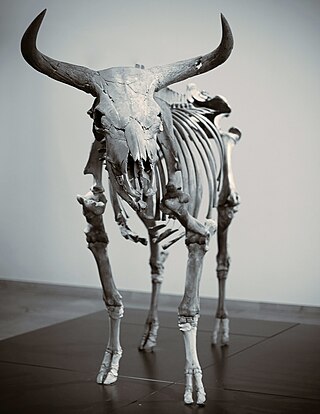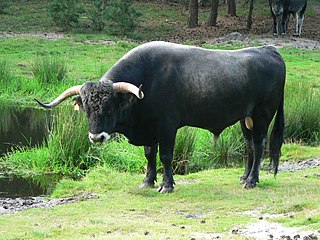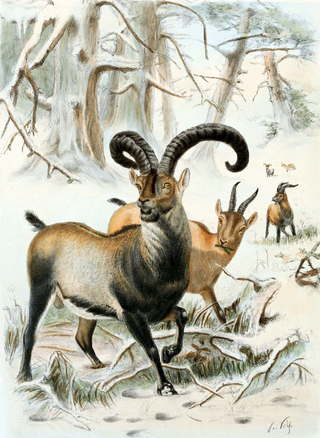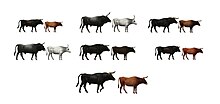
The aurochs is an extinct cattle species, considered to be the wild ancestor of modern domestic cattle. With a shoulder height of up to 180 cm (71 in) in bulls and 155 cm (61 in) in cows, it was one of the largest herbivores in the Holocene; it had massive elongated and broad horns that reached 80 cm (31 in) in length.

Breeding back is a form of artificial selection by the deliberate selective breeding of domestic animals, in an attempt to achieve an animal breed with a phenotype that resembles a wild type ancestor, usually one that has gone extinct. Breeding back is not to be confused with dedomestication.

The Heck or Munich-Berlin is a German breed or type of domestic cattle. It was bred in the 1920s by Heinz and Lutz Heck in an attempt to breed back the extinct aurochs. Controversy revolves around methodology and success of the programme. There are considerable differences between Heck cattle and the aurochs in build, height, and body proportions. Furthermore, there are other cattle breeds which resemble their wild ancestors at least as much as Heck cattle.
Tauros is a transliteration of either Ancient Greek: ταῦρος ('bull') or of Proto-Indo-European *táwros and may refer to:

The Maremmana is a breed of cattle reared in the Maremma, a former marshland region in southern Tuscany and northern Lazio in central Italy. It is raised principally in the provinces of Grosseto, Rome and Viterbo.

Luing cattle are a beef breed developed on the island of Luing in the Inner Hebrides of Scotland by the Cadzow brothers in 1947. It was formed by first crossbreeding Beef Shorthorn with Highland cattle and then breeding the resulting progeny with Beef Shorthorns to produce an animal three quarters Beef Shorthorn, one quarter Highland. The breed of red-brown cattle are moderately sized and extremely hardy. The intent was to produce a good beef cow with the ability to raise a calf under adverse weather conditions. It was officially recognised as a breed by the British government in 1965. The breed is still farmed today, mainly in Scotland but also in other areas of the world.

Ludwig Georg Heinrich Heck, called Lutz Heck was a German zoologist, animal researcher, animal book author and director of the Berlin Zoological Garden where he succeeded his father in 1932. A member of the Nazi party from 1937, he was a close hunting friend of Hermann Göring, and worked under him. One of his projects was the reconstruction of extinct animals such as the aurochs through cross-breeding of various modern breeds which he thought had parts of the original genetic heritage. Heck cattle and Heck horses are named for the resulting animal breeds.

The Sayaguesa is an endangered Spanish breed of domestic cattle. It is named for the comarca of Sayago in the province of Zamora, in the western part of the autonomous community of Castilla y León, and is raised almost exclusively in that area. It may also be known as the Zamorana, the Moles de Sayago or the Castellana variedad Sayaguesa. It was traditionally kept mainly for draught work, but is now raised principally for meat.

Pleistocene rewilding is the advocacy of the reintroduction of extant Pleistocene megafauna, or the close ecological equivalents of extinct megafauna. It is an extension of the conservation practice of rewilding, which aims to restore functioning, self-sustaining ecosystems through practices that may include species reintroductions.

The Heck horse is a horse breed that is claimed to resemble the tarpan, an extinct wild equine. The breed was created by the German zoologist brothers Heinz Heck and Lutz Heck in an attempt to breed back the tarpan. Although unsuccessful at creating a genetic copy of the extinct species, they developed a breed with grullo coloration and primitive markings. Heck horses were subsequently exported to the United States, where a breed association was created in the 1960s.

The Tudanca is a traditional Spanish breed of cattle from Cantabria, in northern Spain. It takes its name from the village of Tudanca in the Comarca de Saja-Nansa in western Cantabria. In the past it was a draught breed, much used for transport of goods to and from the ports of the Cantabrian coast; it is now reared for meat, but is still used in traditional sport of arrastre de piedra, or "stone-dragging". Despite its geographic proximity, it is not closely related to the other cattle breed of Cantabria, the Pasiega.
Pajuna is a rare Spanish cattle breed, originating in Granada (Andalusia), which resembles the extinct aurochs, the wild ancestor of domestic cattle, in certain features.
Stichting Taurus is a Dutch foundation which uses large herbivores grazing under natural circumstances for nature conservation. Robust cattle and horse breeds are used for this purpose.
Limia, Spanish Limiana or in Galician raza Limiá, is a primitive cattle breed from the Province of Ourense in Galicia in northwest Spain, which in some features resembles the extinct aurochs.

De-extinction is the process of generating an organism that either resembles or is an extinct species. There are several ways to carry out the process of de-extinction. Cloning is the most widely proposed method, although genome editing and selective breeding have also been considered. Similar techniques have been applied to certain endangered species, in hopes to boost their genetic diversity. The only method of the three that would provide an animal with the same genetic identity is cloning. There are benefits and drawbacks to the process of de-extinction ranging from technological advancements to ethical issues.

The Taurus Project of the German Arbeitsgemeinschaft Biologischer Umweltschutz aims to re-create the extinct aurochs, the wild ancestor of domestic cattle, by cross-breeding Heck cattle with aurochs-like cattle, mostly from Southern Europe. Herds of these cross-bred Taurus cattle have been established in Germany, Denmark, Hungary and Latvia, and are used in conservation of natural landscapes and biodiversity.

The Uruz Project had the goal of breeding back the extinct aurochs. Uruz is the old Germanic word for aurochs. The Uruz Project was initiated in 2013 by the True Nature Foundation and presented at TEDx DeExtinction, a day-long conference organised by the Long Now Foundation with the support of TED and in partnership with National Geographic Society, to showcase the prospects of bringing extinct species back to life. The de-extinction movement itself is spearheaded by the Long Now Foundation.
Rewilding Europe is a non-profit organization based in Nijmegen, the Netherlands, dedicated to create rewilded landscapes throughout Europe. The group's efforts have contributed to increase the stock of previously endangered species such as the European bison and the Iberian lynx.
Podolian cattle is a group of cattle breeds characterised by grey coats and upright and often long horns that are thought to have originated in the Podolian steppe.

Milovice Nature Reserve is a nature reserve next to the towns of Milovice and Benátky nad Jizerou in Nymburk District, Central Bohemian Region, Czech Republic. Established in 2015, the area is administered by the Česká krajina o.p.s. organization, as a part of Evropsky významná lokalita Milovice-Mladá CZ0214006 protected area, part of the European Union project Natura 2000. This reserve is a pioneering project of cooperation between several scientific bodies and draws support from many organizations and private sponsors.















